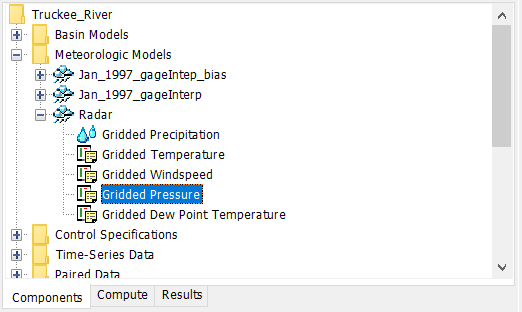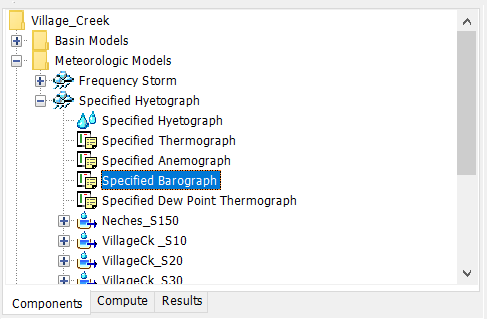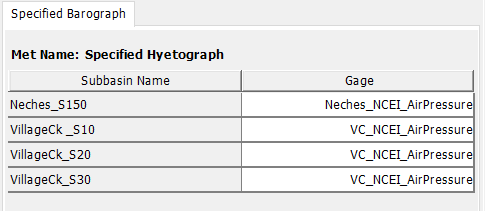Pressure in meteorologic terms is the pressure exerted by the weight of the atmosphere. Pressure is affected by a variety of factors including Air Temperature, Altitude, and Humidity. Pressure also plays an integral role in several other meteorologic processes available to be modeled in HEC-HMS including Evapotranspiration, Relative Humidity, Longwave Radiation, and Snowmelt.
The Pressure Method included in the Meteorologic Model is required when certain types of Evapotranspiration Methods or Longwave Radiation Methods are used. Two methods Gridded Pressure and Specified Barograph are available for adding pressure data to the Meterologic Model. More detail about each method is provided in the following sections.
Gridded Pressure
The most common use of the Gridded Pressure Method is to utilize radar-based pressure estimates. Using additional software, it is possible to develop a gridded representation of pressure data or to use output from atmospheric models. If it is used with a transform method other than ModClark, an area-weighted average of the grid cells in the subbasin is used to compute the thermograph for each subbasin.
The Gridded Pressure Method includes a Component Editor with parameter data for all subbasins in the Meteorologic Model. The Watershed Explorer provides access to the Pressure Component Editor.

The Component Editor for all subbasins in the Meteorologic Model includes the selection of a datasource. Gridded Pressure data must be stored as a pressure grid before it can be used in the Meteorologic Model. The data may be from radar sources or could be the result of complex calculations exterior to the program. Regardless, the grid data must be stored as a temperautre grid. Only pressure grids already defined will be shown in the selection list. If there are many different gridsets available, you may wish to choose a gridset from the selector accessed with the Grid button next to the selection list. The selector displays the description for each gridset, making it easier to select the correct one.

The Time Shift can be used to correct for pressure grids stored with a time zone offset. All calculations during a simulation are computed assuming an arbitrary local time zone that does not observe summer time (daylight savings in the United States). Set the shift to zero if all the time-series and grid data is referenced in same local time zone. If other data sources such as observed discharge or precipitation are referenced in local time and the pressure grid is in referenced to a different time zone, select the correct shift so that the pressure data will match the rest of the data.
Specified Barograph
The Specified Barograph Method includes a Component Editor with parameter data for all subbasins in the Meteorologic Model. The Watershed Explorer provides access to the Pressure Component Editors.

The Component Editor for all subbasins in the Meteorologic Model includes the Time-Series Gage of Pressure for each subbasin. A Pressure Gage must be selected for a subbasin. The current gages are shown in the selection list.
